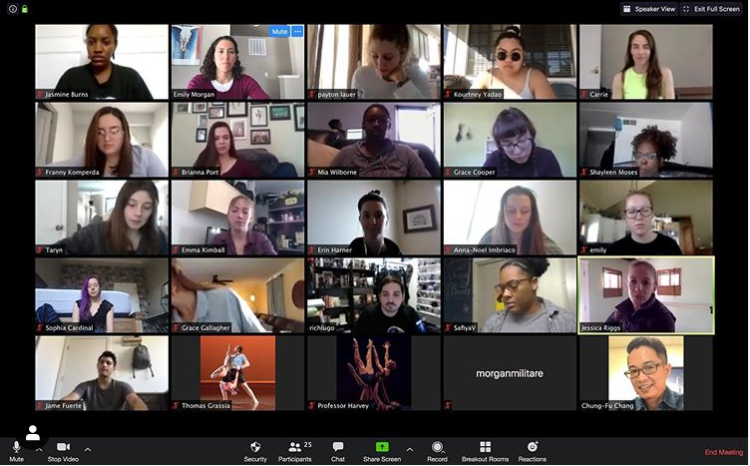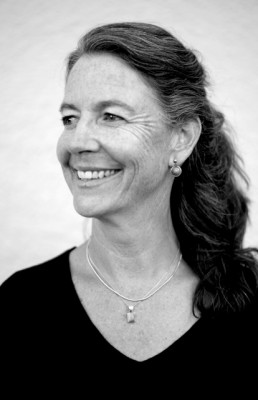The University Center for the Arts is sharing performances to inspire, uplift, and connect us all during this time of isolation. In this video, CSU ballet students express their feelings through dance.
With stay-at-home orders due to COVID-19, many of us have found ourselves sitting more and moving less than usual. The aches and pains of life at a desk (or couch or floor) can be exacerbated when we have nowhere else to go. But for those with a career or academic studies that are always physical in nature, the adjustment has been significant.
Without access to the “tools” of the trade: the Marley floor, the ballet barre, the walls of mirrors, the literally hands-on instruction of a teacher guiding your foot or your classmate spinning by, CSU Dance students and faculty are coming up with new ways to dance, deliver curriculum, interact with students, and accomplish semester–end assignments.

Emily Morgan, director of CSU Dance, has been working closely with her faculty and students to ensure that they can not only have their dance lessons, but also maintain their close-knit community who relies on one another for feedback on daily technique training, creating and rehearsing choreography, and interacting throughout their day.
“Dance is inherently more intimate than other academic disciplines. Tactile feedback from one another is a critical component of the process. With physical/social distancing, we lose a fundamental part of our discipline/our practice.” – Emily Morgan
First, the technology.

Zoom is the preferred method for conducting class so that everyone can see everyone else in the class (albeit in a tiny square), and class is held synchronously, at the same day/time so that students can engage with one another and the instructor. In addition, the class uses the breakout rooms in Zoom to allow students to interact with and critique one another. A nice addition to the live classroom experience is the music played by Dr. David McArthur and Michael Davidson, who play piano and percussion.
“Music plays a very important role. At the most basic level, it provides a steady beat with which to move. More importantly, it provides color, texture, and nuance – there are accents that can help students with their quality of movement. It can carry a dancer through an exercise,” says Morgan who dances from her living room now.
The 50 dance majors are evaluated on their concentration, physicality (alignment, flexibility, strength, endurance), technique (efficiency and execution of movement, weight transfers, use of space), dynamics (energy, effort and quality of their movement), artistry (their expressiveness, risk-taking, presence, musicality), engagement, and professionalism. And that proves difficult in a space that’s reduced to a 2’x2’ square.
“We’re often staring at small rectangles with dancing people inside of them. It is challenging to see three-dimensionally and to analyze as much as we’d like to – and really need to – see,” says Morgan.
Nevertheless, the dancers and their instructors are moving ahead.
Jasmine Burns, senior dance major, has found dance practice at home not too difficult. “Luckily, the dance community, both nationally and internationally, has rallied together and made virtual dance easily available. Along with [my university] classes, I am able to take extra dance classes for free from teachers all over the country on Zoom or Instagram,” she says.
The downside, as Burns says, is the lack of human contact: “The most challenging part of taking dance classes online is that we no longer have the benefit of human contact or ability to feel the energy of another dancer in the space with you. If I get lost during a combination at home I can’t just glance at the dancer next to me. On the plus side, this has made me take more accountability and trust myself.”
And indeed, for Burns, the social distancing element of her academic career is proving beneficial. “I am learning a lot of self-discipline since I must be even more proactive when it comes to my technical training. I am also learning that I push myself harder in this new environment, because I don’t feel judged. This has given me the great chance to push myself in my dance training and to gain more confidence,” she says.
Judy Bejarano prepares material for her Intermediate Modern Technique class that is meeting virtually two days a week.
Next, the community.
Morgan sends a weekly video update to her faculty and students with important information and deadlines, as well as personal information. Other faculty have joined in on the update, sharing videos of themselves and their families, their homes, their dance spaces. Students are showing off their living, learning, and working spaces, and introducing their classmates to pets, roommates, and family members.
“The relationships I have gained in this dance community are the best part of being in a part of a loving and caring group of people with a shared interest,” says Burns. “I love to do conditioning, stretching, or little dance combos with my friends over Facetime.”
Always, the movement.
“Moving brings people together, ideally in person, but also virtually,” says Morgan. “Move your body every day, whether that’s yoga or taking walks.” And there is a proliferation of online dance classes, some free, some donation, some for a fee – and many are offered by high caliber professionals such as the Ballet Barre with NYC Ballet principals.
“Whether you’re a dancer or not, I would suggest playing your favorite music for 15 minutes a day and having a little dance improv session. This is how I can personally find freedom in a time when I can easily feel trapped,” says Burns.
Lisa Morgan and Teaching Creative Movement
One of the dance classes held this semester that has been a challenge to recreate is the pedagogy class called Teaching Creative Movement to Children, taught by Lisa Morgan (no relation to Emily).
This course is a teaching practicum experience for the dance students, where they design lesson plans alongside a Pre-K – 4th grade teacher from Poudre School District to integrate dance/movement skills into the curriculum.
“Students quickly moved into creative problem–solving mode and either recorded their classes and produced an online version, or prepared to teach a live class via Zoom or MS Teams,” says Lisa Morgan. “We also utilized other online resources to share the class schedule and a with detailed information on the classes and how to access them. This opened up the classes to students and families across Colorado and the country!”
For the elementary students to participate, families must have the technology to participate and a space to move in. The CSU students had to develop different strategies for planning and delivering classroom content that is interactive, physically engaging, and educational.
While the students are doing the best they can, “I don’t think anything can replace this [in-person] experience. Our students had to teach to a blank screen with no immediate feedback or response to their direction, ideas, movement prompts, etc. This experience is essential for pedagogy training,” says Lisa Morgan.
A benefit from this virtual experience is that the CSU students are able to learn from alumni from the CSU Dance program. Carrie Demos (‘09) and Rich Lugo (‘14), both currently in New York, have jumped in to help.
“Carrie Demos was excited to join in the process and support the schedule with movement classes for the same age group,” says Lisa Morgan. “This allowed for our students to observe those classes and learn from someone who has been in their shoes and gone on to develop a professional life for herself in New York City where she teaches with NYC Ballet and the American Ballet Theatre, specializing in early childhood dance. This also offered additional classes to our Colorado families.”
It was similar with Rich Lugo. “With our online platform, it was easy to connect with Rich who teaches dance at Fordham High School in the Bronx and bring him into our classes,” says Lisa Morgan. “This was another great opportunity for our students to connect with someone who has been in their shoes and has utilized his dance degree in ways that is allowing him to work professionally in the field of dance.”
Read about the other ways Lisa Morgan uses dance to help others

“I strongly recommend making it a priority to get OFF our screens: Get outside, go for a walk, work in the garden, go for a bike ride. We need to allow our minds to process information/experiences away from the computer and engage our bodies in ways that are both familiar and healthy, and not completely on the computer. Try to maintain your level of physicality that you had before the pandemic for both body and mind. Get creative, have fun, connect with family and friends, and help others in need in our community” – Lisa Morgan